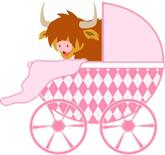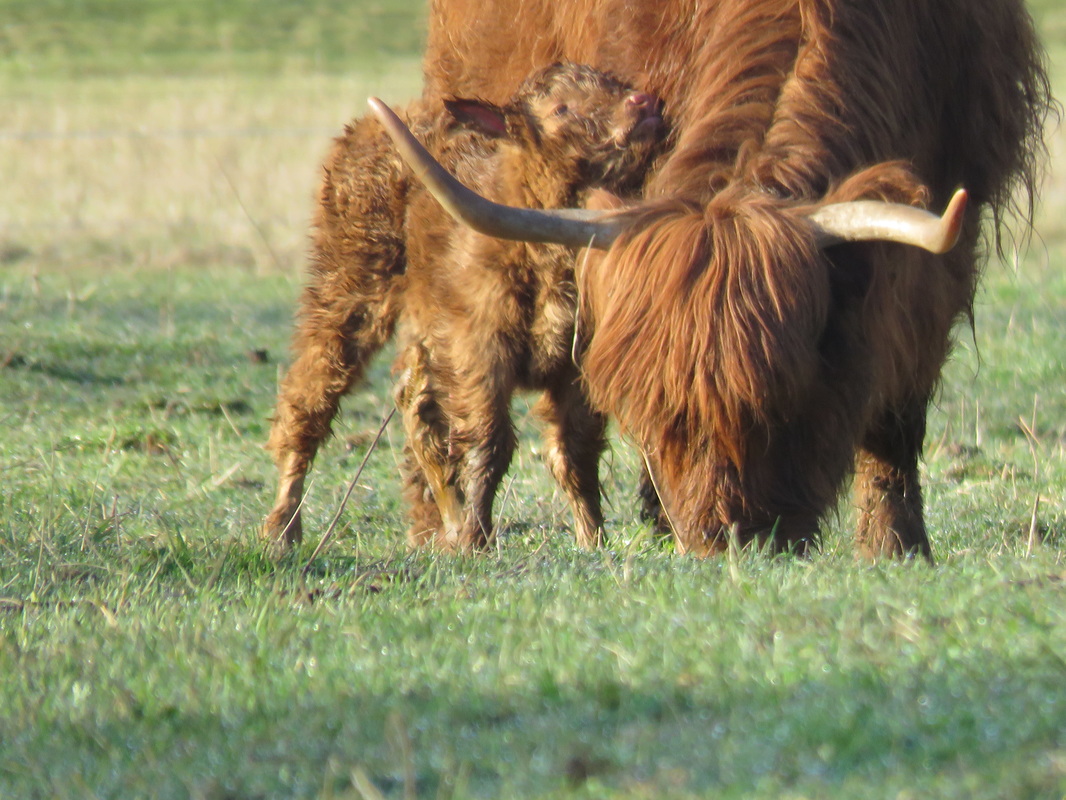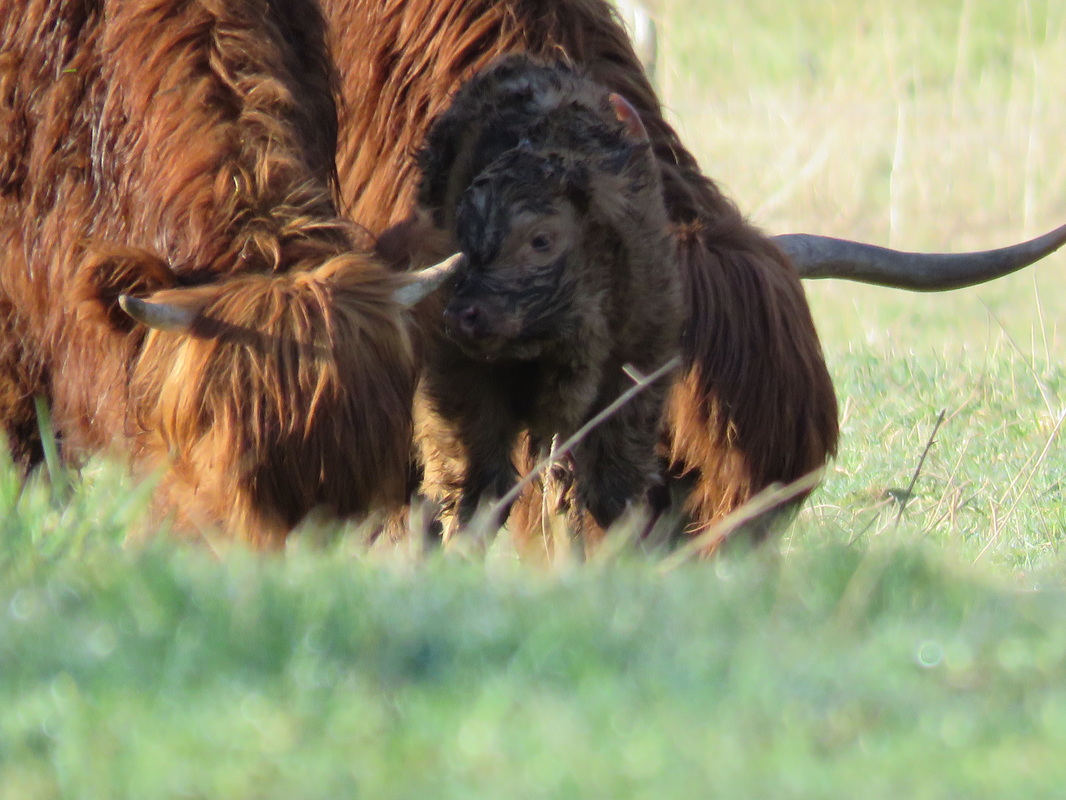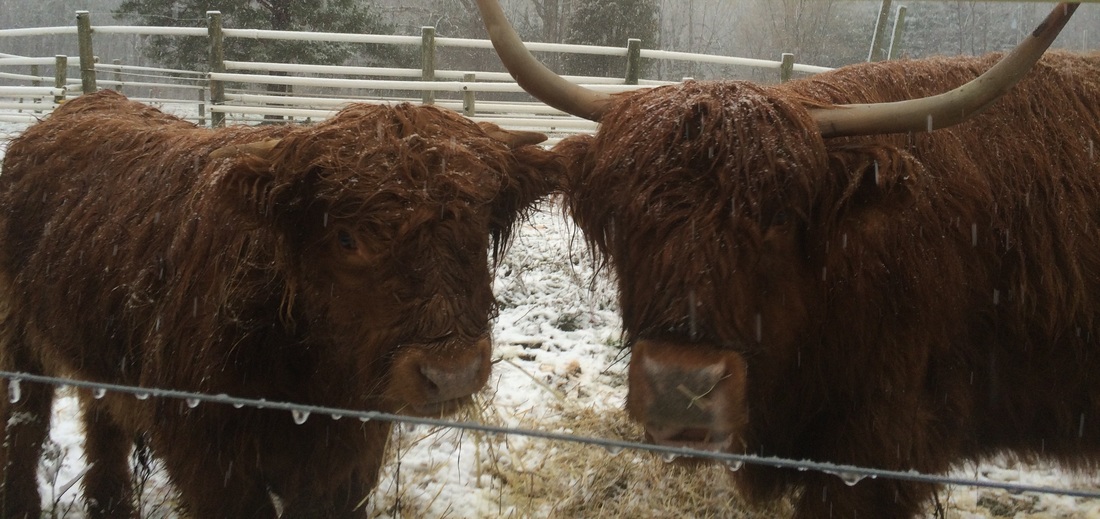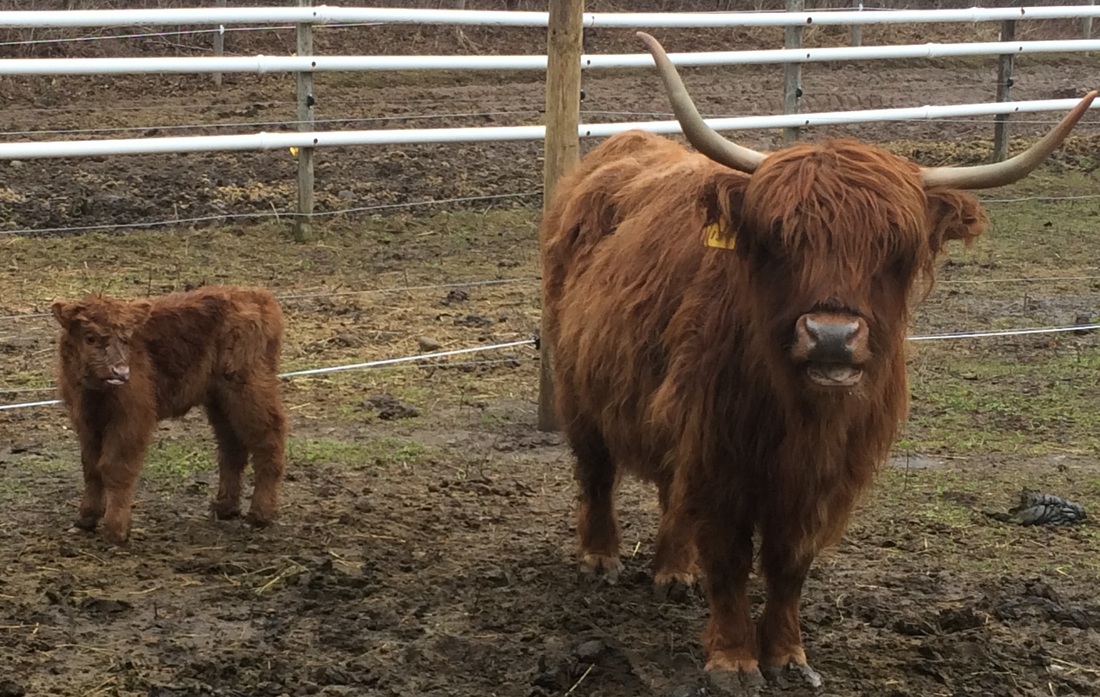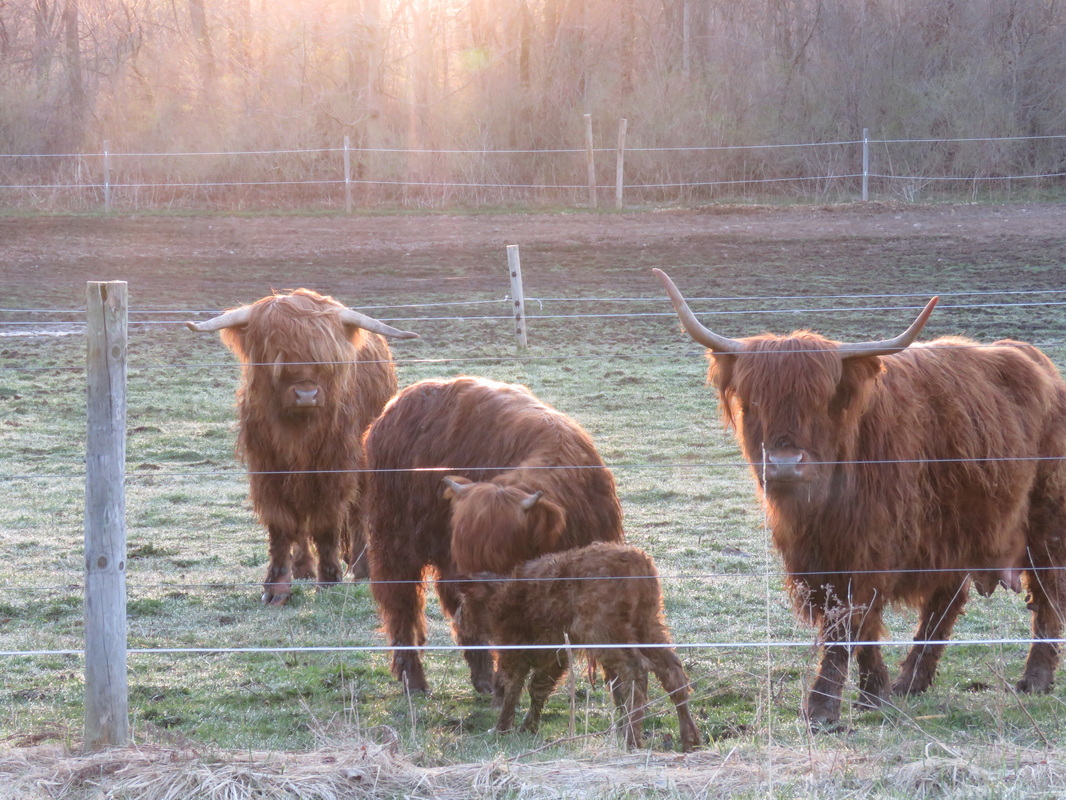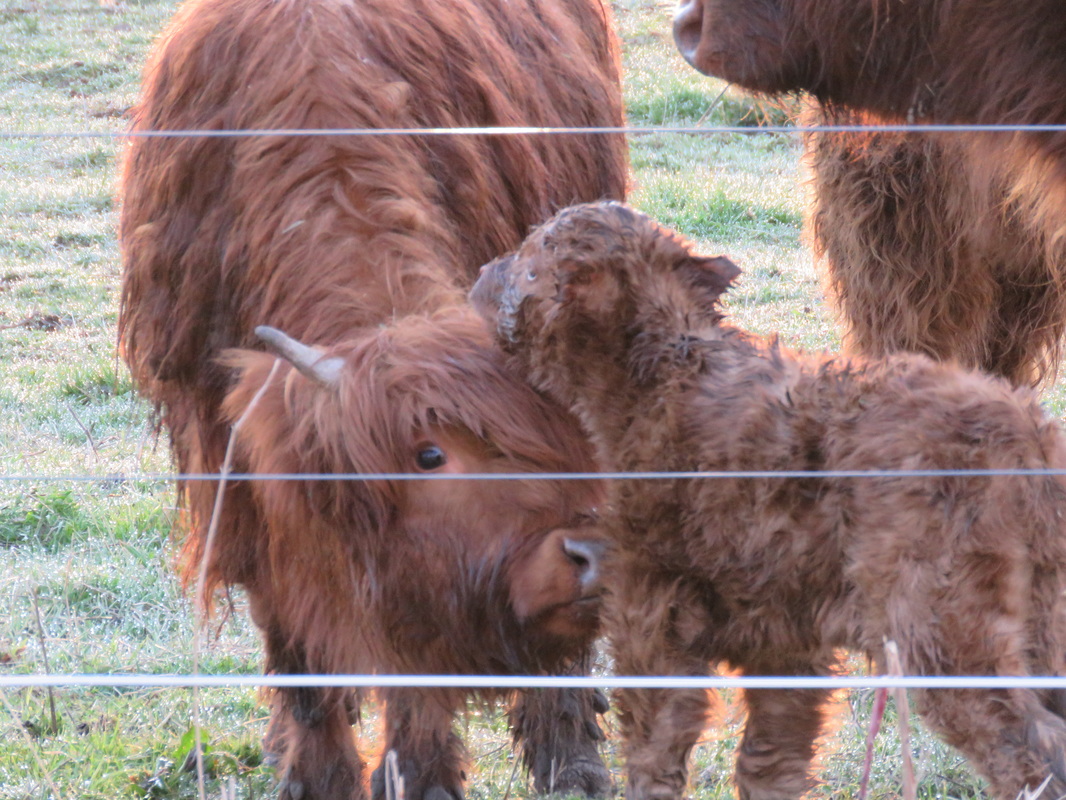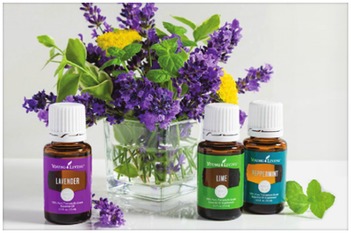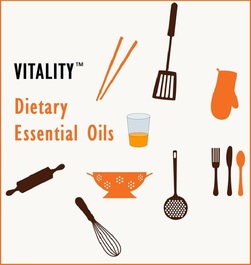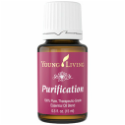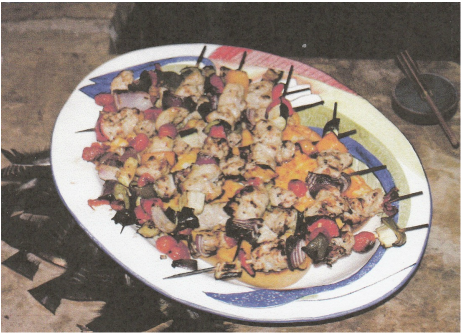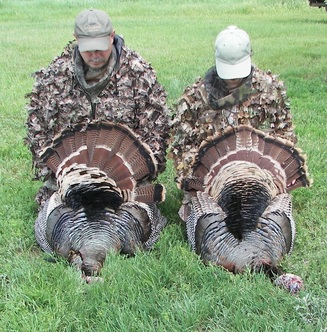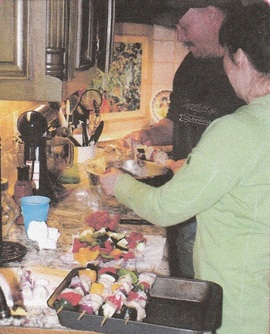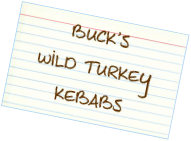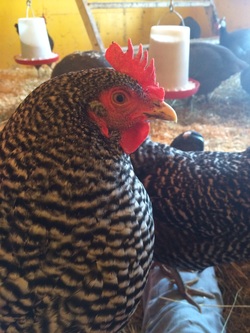OUR GROWING FAMILY of SCOTTISH HIGHLAND CATTLE
|
Having a homestead and raising animals requires constant flexibility and ingenuity of mind and personality. I am one of those unique people who is left brain dominant but almost as strong is my right brain. I am analytical, organized and detail oriented. But, I am also creative, think outside the box and have plenty of imagination. Sometimes there is conflict between the two which creates internal battles in my mind. The tug of war begins and it’s anyone’s call as to which side will win.
As much as I like having my place organized efficient and a routine – animals teach you quickly that whatever schedule you may have intended for that day or morning is quickly out the window and a new plan is at hand based on their needs, moods or problems. It is also a constant reminder that no matter how much planning and research you do – you WILL fly by the seat of your pants, you WILL need to improvise and you WILL always learn something new. When we decided to get our heritage breed (see March Issue) Scottish Highland Cattle, we did all the research, all the planning – or so we thought. We purchased a cow who was bred and her bull calf from that spring. The cow (Momma) has great genetics, had had several calves prior, is a proven good breeder and an excellent mother. Momma and Findlay were from a large herd that had a vast amount of range (by Central New York standards) to roam on. They were use to being around the people who owned them and were only handled for worming and any other necessary care. This didn’t matter at the time…we wanted the bull for beef and the mother to supply our next bull for beef or a heifer to trade or breed. That lack of comprehension was a huge mistake. Scottish Highland cattle – females included – have good sized horns. The mother was not planning on becoming buddies with us ever and wouldn’t let us near her calf. When Findlay was finally weaned, we were able to separate him from his mother, put him in a stall and begin the process of gentling him. It took a bit of time and patience, but we were successful. We were able to castrate him, once we finally accomplished this. When he went back out with his mother, she herded him away from us and dictated his movements. On Palm Sunday the following spring (2015) Holy Cow was born. Fortunately she took an immediate liking to Findlay and looked to him as if a “big brother”. When Findlay would come to have his head scratched or get apples, she watched it all and processed it. That summer Momma and Holy Cow went to “Summer Camp”. Back to where we had bought her so she could spend the summer with their bull to hopefully be bred again. While Momma was gone, Findlay enjoyed a summer of scratching, apples, peppermints and chilled watermelon on hot days. Momma returned in the fall, Holy Cow now weaned. And so we began again the gentling process, this time with Holy Cow. Another slow process – months, in fact, but we gained her trust and found she loved to have those big shaggy bangs of hers brushed and her head and ears scratched. Peppermints were discovered as a wonderful thing and she loves homemade granola. Back out in the pasture with Momma and Findlay, after months of gentling and again Momma dictates the rules and seldom lets either of them come to us. Little Iseabail under Momma's protective guard
Iseabail, safe and sound under Holy Cow's and Momma's watch
|
Findlay and Momma their first winter at the Buck 'n' Mule Farm
Holy Cow (born on Palm Sunday) and Momma - Spring 2015
The whole family checks out the new arrival
Holy Cow welcomes her new little sister, Iseabail, into the world
I am not a “cow” person. I had never had cows or spent time around them. There have been several times over the past two years I have asked myself if this was the right decision. The only part I feel was not the right decision for us was to get a cow that was not handled or halter trained. With my lack of experience and us not having the luxury of a squeeze this was an awakening. We have been fortunate with the little ones to have gentled them so we can put them in a stanchion to give them shots or to worm them. Momma remains elusive. Thankfully, throughout this learning experience, Buck has had more knowledge and guts than I, and has picked up where I've fallen short.
This Spring we have a new arrival and with it more decisions to be made. Holy Cow is now a year old. She can't be bred for at least another year. Findlay’s fate this Fall will be the ultimate sacrifice so that we will have food on our table. I've never had to butcher and eat an animal I have raised – so there will be many unsure moments with that. Momma’s new baby, Iseabail, brings new decisions to be pondered whether we decide to keep Momma another year, breed her again, or sell her – all need to be considered. Do we want to continue to keep cows? - something I've contemplated and we've discussed. Buck feels that keeping the cows is the right decision – and as long as we continue to work as partners with them, I support it. With the sweet little heifer, Iseabail, looking at me and the world with wonder and curiosity, it's hard to not want to keep them. Many questions to be answered, a lot to think about. That is every day on the farm. |
ESSENTIAL OILSEach month we will share ways on how to safely use essential oils on your equines and your other pets. These are recommendations and not all inclusive uses of essential oils for your animal. Remember, all animals are individuals - so observe their behavior as you use essential oils (or anything) to see how they react to them.
WAYS TO USE ESSENTIAL OILS:
|
|
Mary Lainhart is a Young Living OIls independent distributor because after years of her own successful use of them, she's confident of the purity and quality of Young LIving products. The Everyday Oils™ collection is the perfect beginner's kit, containing ten of Young Living's most popular and versatile essential oils. This kit will become a useful part of your day, everyday.
Visit the Wild Heart Mustangs™ SHOP to purchase and read detailed descriptions of each Young Living oil and blend.
For use instructions and cautions, please refer to each individual product label. Dietary Essential Oils
Perfect for adding flavor to your favorite foods or using as dietary supplements, the Vitality™ line of dietary essential oils gives you the freedom to share and explore some of our best-loved essential oils in a variety of nutritious and delicious ways. We invite you to discover Vitality™—for food, for family, for life! PURIFICATION ESSENTIAL OIL BLEND
Many of the uses for your animals are the same as for you, making this a very useful oil to have on hand. For your animals it is useful for fleas, ticks and mosquitoes. It can be rubbed on or used in a spray bottle with water. For birds you can mist the cage, rather than rubbing it on. Purification® aids in immune support and protection from parasites.
Purification® is a good first aid essential oil (see the April Issue of Homesteading) because of its antibacterial and antimicrobial activity. It is also great mixing with water in a spray bottle with water for freshening the barn, saddles, saddle pads or anything else that needs deodorizing. Young Living USB Diffuser. Use in any USB plug, on your laptop, in your car, anywhere! Over the years I have tried just about every type of diffuser out there. Clay, Cotton, Felt Pads, Ceramic, Cotton Balls to name a few. None of them gave me the lasting results I was looking for or the ease of use. Clay and Ceramic are inconsistent at best. Cotton, Felt Pads, Cotton Balls were not only not what I was hoping for results of fresh, clear aromas, they needed to be replaced frequently. This YL USB diffuser is the best diffuser I've ever purchased that was not water based. It comes in Black, Pink and Purple and all can be purchased from the Wild Heart Mustangs™ Shop.
|
Springtime is turkey hunting time. Buck Lainhart has just the recipe for you to try wild turkey and make it delicious.
MAKING WILD TURKEY DELICIOUS
|
BUCK'S WILD TURKEY (not the kind in a bottle!) KEBABS
Ingredients: Breasts* from two (more or less) wild turkeys (adjust to what you were fortunate enough to harvest that day) 1 cup vegetable oil ½ cup white wine vinegar Add the following seasonings to your liking: Garlic powder Lemon Pepper Salt Basil – fresh, chopped or dried (use about twice as much fresh as you would dried) Onion Powder Black Pepper Splash of white wine – to taste (optional) Fresh vegetables – whatever’s in season or that you like. We used red, yellow and green bell peppers, purple onions and cherry tomatoes. You could also use mushrooms, zucchini, summer squash, eggplant, and Vidalia onions. Cut them into chunks about 1-1/2” to 2” wide. You’ll also need metal or bamboo skewers Remove the silver skin, any fat and tendons from the breasts. Cut them into 1-1/2” chunks. Mix the oil, vinegar, and seasonings in a large bowl. Add the turkey breast chunks and toss well to coat with the marinade. Cover and refrigerate for one or two days, mixing periodically. If using metal skewers, coat them with cooking spray. If using bamboo, soak them in water for about 30 minutes before using them (stick them standing up in a tall tumbler, or lying down in a baking pan filled with water. Remove the turkey from the marinade, saving the marinade. In a small sauce pan, boil the leftover marinade for 2-3 minutes (that’s safety measure you must not skip). Set it aside. Put the turkey and vegetables onto the prepared skewers, alternating the meat and different vegetables. Place the loaded skewers on the grill and cook slowly, turning the skewers often so that they cook evenly. Brush the meat and veggies with the leftover marinade if they start looking too dry. To see if the kebabs are done, poke a chunk of turkey with the pointed end of a skewer (or knife, fork, or toothpick). If the juices are still pink, cook for another 5 minutes. If the juices run clear, the meat is ready to serve. An alternative to cooking on skewers you can make spiedies. Put the veggies and marinated turkey in a grill basket that’s been coated with cooking spray. Marinate the same as kebabs. Cook on grill in a grill basket and eat as the main course or as a sandwich. The marinade is also delicious with venison. *To breast fowl, see the instructions in our February Issue |
Buck and Mary preparing the wild turkey kebabs with the Rio Grande turkeys they harvested in Texas.
|
RESOURCES FOR HOMESTEADERSDISCLAIMERThe information contained on this website is not meant to diagnose, treat, cure, or prevent any disease. The information on this website represents what I have chosen to do to take charge of my own personal health and that of my family. Statements on this website have not been evaluated by the Food and Drug Administration. If you are pregnant, nursing, taking medication, or have a medical condition, consult your physician before using these products.
Information found on this website is meant for educational and informational purposes only, and to motivate you to make your own health care and dietary decisions based upon your own further research and in partnership with your health care provider. |
